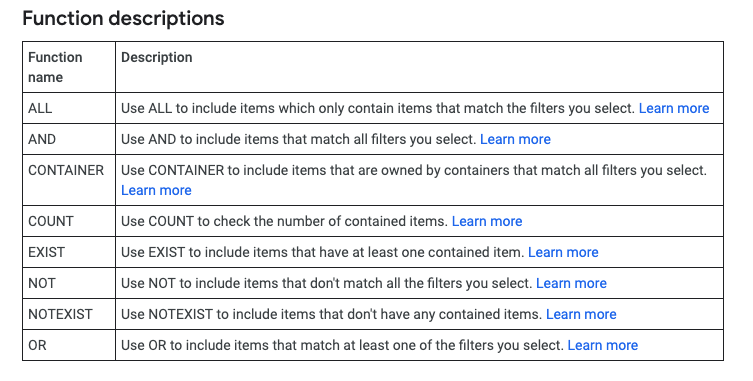

Get monthly notifications
How the filter function in Google Ads Editor can be a real time-saver
Google Ads filters allow you to quickly view and analyze various metrics, and you can thereby identify and handle opportunities as well as problems straight away. Filters are also a great way of keeping track on tabs for your account, keyword changes, and campaign performances, and it is a great tool for PPC management.
With filter functions, you can use powerful queries that combine filters in new ways to find highly specific items in your Google Ads account. In Google Ads, you’ll find eight functions. With these filters, you can identify problem areas within your keywords, ads or campaigns. Below are some function descriptions derived from Google Ads Editor.

Three ways to use the filter function
1) Low-quality keywords
Quality scores can change a lot depending on various factors, so you want to be aware of keywords with a low-quality score. If you create a filter, it makes it easier to see what these changes are and when they appear. You can hereby decide whether to keep using these keywords or not.
For instance, you can create a filter that shows only quality scores under three. If you, after some time, realize that these scores haven’t changed – then you should probably not run these keywords anymore.
2) Ad category filter
Creating a filter for ad categories is especially important if you have recently created categories. Maybe you’ve just launched a new category for sneakers and you want to keep track of that specific category, then you can create several pilot ad categories to monitor how the category performs over time. By creating a filter that sorts on the ad category name containing the word “pilot”, you can see how your optimizations evolve over time and how they impact the quality scores for your sneakers.
3) Low ROI campaigns
Campaigns with a high performing ROI can be set aside. Instead, you need to look at the campaigns that aren’t performing as well. Maybe you’ve set a CPC that is too high, and too many clicks have been spent on these. To filter out these campaigns allows you to quickly see where adjustments need to be made.
Learn more about increasing ROI in Google Ads: Top 3 ways to increase ROI in Google Ads.
Another key function in Google Ads is audience lists. Read more about how to use them here: 3 most important audience lists in Google Ads.
Featured Articles
The Full Funnel Approach and Pinterest
Today, we're going to delve into the significance of working with a full-funnel strategy and understanding why a comprehensive media mix is crucial. We'll also explore an example of how this approach and including Pinterest in the media mix led to a significant decrease in the cost of sales for Houdini.
Master Text Overlays: Boost Ad Engagement
In recent years, capturing the attention of your target audience has become more challenging than ever. Businesses and marketers are constantly on the lookout for innovative ways to stand out in the crowded advertising landscape.
One effective technique to draw attention to your ad's message is through the use of text overlays on image and video ads. In this blog, we will explore the best practices for incorporating text overlays, ensuring your message is impactful without compromising the visual appeal of your ads.
Similar Articles
Protect Your Facebook Business Account from Phishing: Expert Tips by Keywordio
Hello everyone, Johan here from Keywordio. Today, I want to share crucial insights into phishing—what it is and how you can safeguard your Facebook business account from this prevalent threat.
Exploring the Future of TikTok: Insights from the 2024 Trend Report
Introduction
I'm excited to delve into TikTok's comprehensive "What's Next 2024 Trend Report." This report is a treasure trove for anyone in digital marketing, offering deep insights into the future of content, storytelling, and consumer engagement on TikTok.
E-Commerce Excellence: Meta's Advantage+ Shopping Campaigns Redefined
Welcome to the dynamic world of e-commerce, where Meta's Advantage+ shopping is reshaping how businesses connect with customers. In this blog post, we'll explore the key features of this innovative tool.
Introducing TikTok Shop
Today, I bring to your attention a revolutionary update from TikTok, a platform where over 150 million Americans seek daily doses of inspiration and entertainment. With a plethora of trends, fashion hacks, beauty nuggets, and a smattering of recipes, TikTok has emerged as a modern-day oracle for curious minds. The excitement in the air thickens as we unveil TikTok Shop to the US, an avant-garde conduit for folks to spot and snag their adored items seamlessly.
The Full Funnel Approach and Pinterest
Today, we're going to delve into the significance of working with a full-funnel strategy and understanding why a comprehensive media mix is crucial. We'll also explore an example of how this approach and including Pinterest in the media mix led to a significant decrease in the cost of sales for Houdini.
Master Text Overlays: Boost Ad Engagement
In recent years, capturing the attention of your target audience has become more challenging than ever. Businesses and marketers are constantly on the lookout for innovative ways to stand out in the crowded advertising landscape.
One effective technique to draw attention to your ad's message is through the use of text overlays on image and video ads. In this blog, we will explore the best practices for incorporating text overlays, ensuring your message is impactful without compromising the visual appeal of your ads.
The Next Big Thing: 5 Digital Marketing Trends to Watch for in 2023
Digital marketing is a constantly evolving field, shaped by emerging technologies, changing consumer behaviors, and the dynamic nature of the online landscape. Staying on top of the latest trends is crucial for businesses and marketers to effectively engage with their target audience and drive growth. In this introduction, we will explore some of the key digital marketing trends that have emerged in recent times.
The Power of Branding on Meta
Are you ready to unlock unparalleled opportunities and take your online business to new heights? In a rapidly evolving digital landscape, Meta continues to revolutionize the way marketers and entrepreneurs create an impact on buyers.
Today, we will talk about the immense potential of branding on Meta's platforms, Facebook and Instagram based on our Meta Branding (Online Course). Brace yourself for insights that will empower you to establish a strong brand identity, harness consumer trends, and optimize your advertising strategies like never before! Ready to spearhead your business to success? by understanding the potential of branding on Meta and how you can tap into it. Excited? So are we - let's get into it!
A Sneak Peek into Pinterest's 2023 Product Updates!
Pinterest is improving its Ads Manager to provide a seamless experience for advertisers. New features will be released throughout 2023 to optimize advertising strategies. Pinterest aims to offer powerful tools and insights for better campaign results. Get a sneak peek into the exciting updates coming to Ads Manager this year.